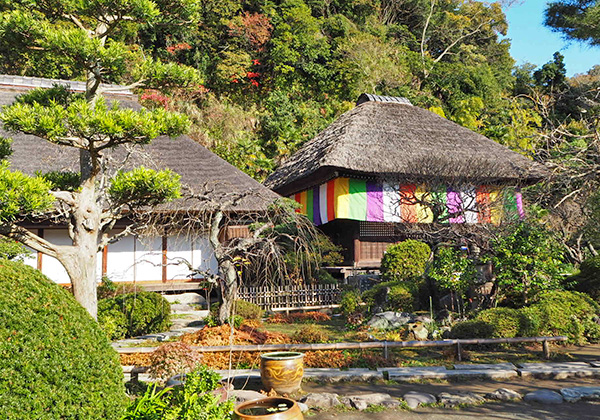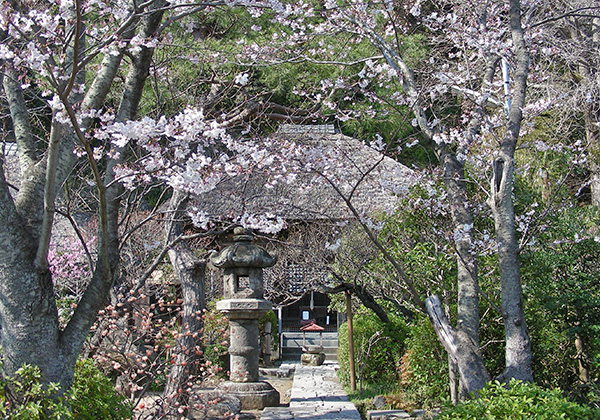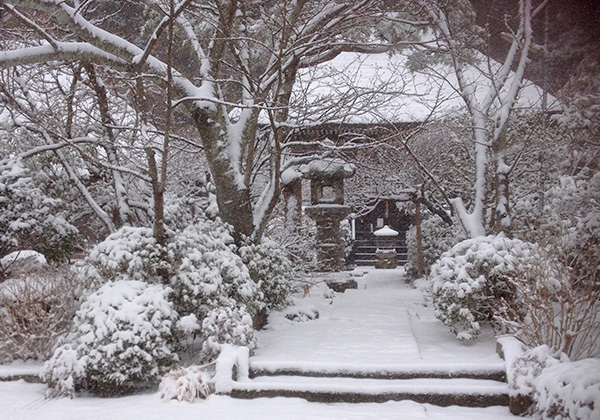Myo-o-in
| Official Name | Hanseizan Kangiji Myo-o-in Godaido {Pronounced han-say-zan kan-ghee-gee myo-oh-in goh-dye-doh} |
|---|---|
| Religious sect | Shingon sect, Buddhism (Mother temple: Nin'na-ji in Kyoto) |
| Founded | in 1235 by Fourth Shogun Yoritsune Kujo {yoh-re-tsu-neh koo-joe} |
| Founding priest | Jogo {joe-go} |
| Main object of worship | Statue of Fudo Myo-o {foo-doh myo-oh} |
| Address | 32 Juniso, Kamakura, Kanagawa 248-0001 (show route from current location ) |
| Location | 2,500 meters east of Kamakura Station |
| Time needed to get there | 30 minutes |
| Admission | Free (open yard) |
| Open | 9:00 - 16:00 |
| Phone number | 0467-25-0416 |
| Restrooms | Not available |
| Note | Event: Homa rite on 28th every month |
Historical Overview
When Third Shogun Sanetomo Minamoto {sah-neh-toh-moh me-nah-moh-toh} (1192-1219) was assassinated in 1219 by his nephew, the military government had difficulty finding the successor, since Sanetomo was young and had no child. After careful deliberations, the government chose a court noble in Kyoto, who was remotely kin to Yoritomo Minamoto {yoh-re-toh-moh me-nah-moh-toh}, the founder of the Kamakura Shogunate and the First Shogun. His name was Yoritsune Kujo (1218-1256), a scion of the Fujiwara aristocratic family. A one-year-old baby, he was brought to Kamakura as the Fourth Shogun six months after the demise of Sanetomo.
As his age tells, Yoritsune's position was obviously titular. The government was already under the reign of the Hojos, the regents in particular, and the real power continued to be in the hands of the Hojo Regents until the Kamakura regime came to an end in 1333.
Yoritsune founded the Temple as his prayer hall in the north-eastern corner of Kamakura at the age of 18. The northeast direction was called kimon {key-mon} (literally, demon's gate), and Yoritsune thought it necessary to erect a temple around here to avoid an unlucky exposure. (The world-famous Enryakuji at Mt. Hiei, Shiga Prefecture, for example, is situated northeast of Kyoto and it was built to guard against demons when the capital of Japan was relocated from Nara to Kyoto in the late 8th century.) Being of noble birth in Kyoto, he adored and loved the Kyoto culture. At Kamakura Hachimangu Shrine, the head of the shrine was Priest Jogo (1152-1238), who had been the chief priest of Toji in Kyoto, the mecca of Shingon sect Buddhism. (Back then, Shintoists sought to harmonize the teachings of Buddhists, particularly those of Shingon sect, with Shinto doctrines, and therefore, Tsurugaoka Hachimangu Shrine had a number of Buddhist elements). Yoritsune believed that Priest Jogo would be the best to be the founding priest of this Shingon temple. The Priest accepted his request to be the founder.
The Shingon sect is often referred to as esoteric Buddhism, as its method of incantations and invocations are too elaborate, complicated and mysterious. Yoritsune performed a full-fledged incantations and prayers from time to time saying it would be for the safe sake of andon behalf of the Hojos and Shogunate. Those religious services were so mysterious and enigmatic that outsiders did not really understand what they were doing. Ritual objects used during the incantations, for instance, can be grouped into three categories: Weapons to destroy human lusts and desires, object to make sounds for awakening to enlightenment, and woodchips to burn by which purifications are performed. The services keep on day and night chanting sutras loudly, and burning cedar sticks for the holly-fire rituals called goma or Homa in Skt.
Those religious services made the Hojos suspicious of Yoritsune's behavior. As he grew up, Yoritsune began to feel that he, the Shogun, was only nominal or a puppet with the real power always resting on the Hojos. He began to form a group of loyal samurai who were displeased with the government and gradually gained powers. In the meantime, Yoritsune kept on carrying out similar incantations time and again, which eventually led to misunderstanding between him and the Hojo Regents.
On one occasion, the enigmatic and fervent invocation continued day after day with no apparent purpose. The Hojos suspected it must be a ritual cursing on them or a prayer for the success of an attempt to topple the government. Blaming Yoritsune of his practice, Fourth Hojo Regent Tsunetoki {tsu-neh-toh-key} (1224-1246) suddenly replaced him in 1244 with Yoritsune's six-year-old son Yoritsugu {yo-re-tsu-goo} (1239-1256). Yoritsune's bitter feeling against the Hojos further deepened. In 1246, Regent Tsunetoki died and the post of the new Regent was handed to Tokiyori {toh-key-yoh-re} Hojo (1227-1263) . Shogun Yoritsune thought this would be a rare chance to take over the ruling power, so say historians, and he secretly planned a coup d'etat with his followers.
Unfortunately for Yoritsune, however, the conspiracy leaked out to the Hojos. As a result, he was forced to enter the priesthood the next year and ousted back to Kyoto. The Fifth Shogun Yoritsugu's term in office did not last long either. For the same reason of the plot to overthrow the government, he was dismissed in 1252. It was a sheer coincidence that Yoritsune and son Yoritsugu died in the same year of 1256.
Back at the time, the Temple was one of the greatest religious institutions in Kamakura, comparable to Tsurugaoka Hachimangu Shrine, and chief priests after Priest Jogo always succeeded to the leading priests of the Shrine.
It has to be noted, however, that Shogun Yoritsune was an excellent tanka (31-syllable verse) poet like the Third Shogun Sanetomo and made a good number of tanka. Many of them expressed his feeling of loneliness as the titular Shogun.
Entering the Temple grounds, visitors may notice something different from other temples; There is no graveyard in the Temple, meaning it has no parishioners. (Buddhist temples can roughly be grouped into two: One for the consolation of the departed souls and the other for the incantations.)






